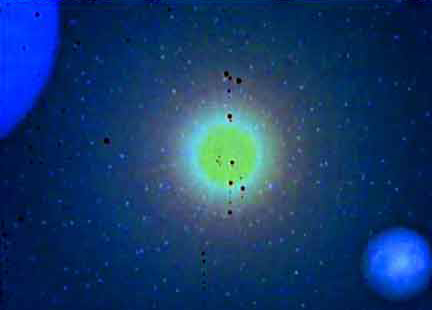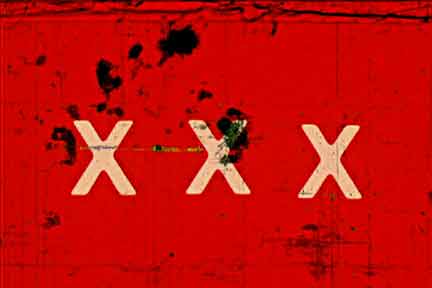The In-Between of Cinema and Spectral Subjectivity in Television´s Touching Evil.
by Gayle Gorman

Touching Evil was a British crime show that ran from 1997 to 1999, consisting of eight two-part episodes, each almost an hour long, that primarily followed the character of Detective Constable Inspector David Creegan of the Organized and Serial Crime Unit. It was adapted for American television in 2004 and very closely followed the plots of each British episode, though the character of Creegan was interpreted differently by the American actor playing him. But in both cases the series begins with Creegan coming back to work after a lengthy healing period necessitated from being shot in the head and subsequently dying in the emergency room, only to be revived ten minutes later. This experience situates him from the start as a liminal subject and, depending on whether it's the British or USA version, someone who has “abilities” or “sensibilities” that allow him to “touch evil”.
I am going to be focusing primarily on the British version.
Although it is a television series and there is much to be said on the nature of seriality inherent in the medium of television, especially in terms of serial killer shows, I am going to treat the work as cinematic, meaning that I’m using the term “cinema” to encompass both film and television for the purpose of this exploration.



My interest in trying to theoretically work with this show started with the title; how does one “touch” “evil”; how does one “touch” via cinema? These questions opened up the gap that exists between materiality and immateriality which, it can be said, lies at the heart of cinema and its purpose or its function, to somehow negotiate this impossible gap and engender a sense of magic and wonder, to indeed keep alive the, according to Freud, primitive and childlike state of animistic belief, the belief that all things are imbued with life force.
This gap is indicated by the "X" that is, according to jan jaogodzinski 1, the excess of the in-between, the excess within the human that is “in-human”, the unquantifiable yet ubiquitous desire between life and death.
Movement, animation, is indeed the difference between life and death. To transgress this border has been the goal of experiments with electricity going back to Luigi Galvani and his experiments with frogs in the 1700s, and up to Thomas Edison’s declaration in 1920 that he could build a machine delicate enough to communicate with the dead 2. From the mid 1800s up to the early 1900s Spiritualism flourished and The Society for Psychical Research’s members, many of them physicists, applied rationalist inquiry into explorations of unexplained communications from beyond our material realm. According to Jeffrey Sconce, electrical technology “was [and are] a means of bodily escape and deliverance from the troubles of a material and depressingly finite universe” 3.
In the 1840s the scientist philosopher Karl von Reichenbach theorized a vital life force he termed “the Od”, “a different form of light” whose “touch provided crucial contact between the empirical realm and the ethereal”. This force appeared in his photographs as “dancing balls” and “floating haloes” 4.
The parallel of seances with wireless telegraphy at the time created a new sense of the subject as disembodied and immaterial, questioning senses of self that, quoting Marina Warner, “challenged ideas of the bounded person” 5, and sought to find out if the soul of a person can exist outside of the body: “an unprecedented ferment about exploring the invisible was occurring” 6.
The inner eye that the technologies of optics had been providing external sight to – technologies that had become, quoting Warner again, “tools for broadcasting the imagination's phantasms into the external world” 7 – was paralleled by the development of psychoanalytic thought. Whereas the scientists and their experiments were looking for a verifiable beyond where the new dislocated self – “the subliminal self” 8 – can transcend the limits of life, materialism and human finitude, Sigmund Freud was looking inward at the psyche itself, the Greek Goddess of the soul 9, and seeing such dislocation.
To quote Sconce again: “Freud’s eventual formulation of the divided subject, an entity haunted by a mysterious realm in the psyche that forever denies the subject a unity of self-presence, is perhaps the foundational and most terrifying of all modernity’s many voids” 10. The inhuman of the human is the void between the striving for life and the striving for death, “the fragile boundary between life and death” 11, the "X" of the death drive. As Jacques Lacan put it: “Freud addresses the powers of life insofar as they open into the powers of death” 12.
The invention of cinema and its mechanisms of time/duration, movement, projection, and proximity finally achieved the ability to animate the inanimate, if only in the realm between the immaterial of light and consciousness and the physicality of celluloid and gears. I’m postulating that ts origins and its site as a space of the in-between situates cinema as a method of the death drive and is especially apparent in Touching Evil.
The following clip from the show embodies and conjures this space as actual (in the narrative of the show), yet virtual (as projected light both within and without the show itself), a cinematic space-as-active-memorial that the police found that a serial killer had purposely led them to, a former aid worker in Bosnia who is now killing the people he was there with as a way to save them from their/his unbearable memories:
“[f]orm without substance, space without distance” 13: the result is, in Michel Foucault's term, an "incorporeal materialism" 14 or, as Marina Warner would put it, a “material mysticism”: “A phantasm in the mind and an image made of light both exist on the obscure frontier of materiality and immateriality” 15. In this scene memory is kept animated as projected immaterial images serve as repeated trauma effects, as well as affect-producers through the immersive witnessing by the police, most especially our main character Creegan.
The very existence of cinema signs for us the paradox of a life co-existent with death, cinema being a medium for externalizing an internal schizophrenic elusion of temporal unification 16. Brian Massumi puts it thusly: “the medium of communication is not the technical, but the internal itself” 17.
To bridge distance between the external to the internal, to touch that which is not tactile, is how cinema’s effects “represent the invisible and the inpalpable” 18, by breaching linear time and physical space.
The character of Dave Creegan and the virtual universe he has helped to open up for us, who has literally returned from the dead, from the beyond, only to be immaterially embodied cinematically as a survivor of a cut or a break, can be thought of as a result of what Marina Warner claims is a “newly developed consciousness of a personal subject” whose “faculties of what used to be called soul – such as fantasy, memory, sensations, emotions – now exist in symbiosis with televisual communications and with the laws that organize them, and the loops and warps in the manifold planes and volumes of space-time that they have brought into play” 19.
In looking at this work I like to think in terms of form and content, especially because of the doublings of doublings that occur in both the narrative and metanarrative, so just for this example I am going to emphasize the doubling too of the two versions of Creegan’s death in the two versions of the television show, the British one more apparently occurring as a flashback:
The flashing back in time is known to us through familiar cinematic tropes that bear special emphasis within the context of the psyche of psychoanalysis: the flash is the light is the glare, not only of the standard recall of a near-death experience, but of Lacan's Real and of Roland Barthe's punctum 20. How can a subject possibly be in two places at once, or is it even fair to say that this, or any, cinematic sample is a "once", an unraveling of time itself, the filmstrip presents and re-presents multiple singular still images, no one occupying the same space or time. Creegan as cinematic subject then, is unraveled in his remembering, in his affective recall; as his eyes close he begins to see.
Creegan’s death is a movement towards a beyond that is already the beyond of cinema. His return is a return to a life that is already disembodied and now doubly so as a cinematic subject. It is important to note that the series never points to the life Creegan had or the person he was before his temporary death – before the series began – except for his failed marriage and the young children he ends up sending away with the agreement that he is not to ever know their whereabouts. The disruptive event of his coming back to life renders time out-of-joint then in more ways than one. To borrow from jan jagodzinski’s analysis of the character Lindsay in the television show Freaks & Geeks, “for such a moment [he] remains subjectless, uncertain and incomprehensive”. His coming back to life (and that includes the life of the filmic fantasy) is “a temporality that confronts a pure difference or disjunction... it initiates a new individuation” in which he becomes “a schizo self” and where “death is affirmed” 21. “[He] becomes unhinged – an uncertainty appears. As [his] identification fades away, what remains is the excess of [his] subjectivity. The "X"... begins to think on its own” 22.
And the reborn Creegan’s death drive propels him as he perpetually travels from nothing to something, from shadow to light and back again, from the immaterial to the repetition of the present as an infinite cinematic return.
And what of touch? To quote Sadie Plant:
“Touch is the feeling that nothing is safe” and “that which is touched always touches back” 23.
So if Creegan can indeed touch evil, the paradoxes that I’ve explored point me to the complication of, not just of touching the immaterial, but of the concept of evil itself. To quote Elenka Zupancic: “the theoretical necessity of rethinking the concept of evil [something that perhaps this show is an exemplar of] is linked to the more general interest in the question of ethics... the thing that makes a certain object or phenomenon evil is precisely the fact that it gives body to the ambiguity of desire and abhorence” 24.
In the universe of this work evil follows the logic of the excess of the "X" as a way to get to a Lacanian ethics of the Real via his notion of the beautiful. As opposed to “the good”, Lacan posits “the beautiful” as a way to think ethics. “For Lacan, beauty is associated with violence, blindness, transgression, and especially death”, wrote Eleanor Kaufman 25. Lacan stated that “[T]he violent illumination, the glow of beauty, coincides with the moment of transgression... [S]omething else is going on on the other side that cannot be observed... the inanimate condition in which Freud taught us to recognize the form in which the death instinct is manifested” 26.
Creegan’s new subjectivity circulates around his death drive and his uncompromising desire – his jouissance –, heralded by his death's illumination, as we saw in his flashback/return. In this short clip he’s confronting a pregnant fire-obsessed serial killer who drugs her victims before setting them on fire. He is trying to save another potential victim by trying to get the murderer to focus on him:
So what is the difference between Creegan and the serial killers he stops? Is it his death wish, his proximity to death, that allows him to “touch evil”? To quote Kaufman again: “Beauty is closer all at once to death, evil and ultimately ethics... [I]t is this proximity to the extreme that for Lacan marks the space of the ethical, a perhaps paradoxical and certainly liminal space where the living and the human confront their limits” 27.
Zupancic’s assertion that evil has no image necessitates “an image of evil that occupies the very place of the lack of an Image”: the glare, glow, or aura of the Real...”not an image, rather that which makes a certain image stand out. It is an effect of the Real on our imagination, the last veil or screen that separates us from the impossible Real” 28.
gayle gorman
1. jan jaogdzinski theorizes this "X" in his book Television and Youth Culture: Televised Paranoia (2008).
2. Edison's planned invention intended to communicate with the dead is considered both fact and hoax. In an interview that appeared in the October 30, 1920 issue of Science magazine he said: “If our personality survives, then it is strictly logical and scientific to assume that it retains memory, intellect, and other faculties and knowledge that we acquire on this earth. Therefore, if personality exists after what we call death, it's reasonable to conclude that those who leave this earth would like to communicate with those they have left here. . . . I am inclined to believe that our personality hereafter will be able to affect matter. If this reasoning be correct, then, if we can evolve an instrument so delicate as to be affected, or moved, or manipulated . . . by our personality as it survives in the next life, such an instrument, when made available, ought to record something......". Cited from: http://www.rockymountainparanormal.com/edison.html.
3. Sconce, p. 44.
4. As written of in Marina Warner's book Phantasmagoria, Karl von Reichenbach carried out experiments with magnetism to produce and photograph this odic force (2007, p. 255-6).
5. Warner, p. 247.
6. Warner, p. 258.
7. Warner, p. 14.
8. The subliminal self was a theory held by Frederic Myers, co-founder of the British Society for Psychical Research (1882) and poet at Cambridge who first used the term "telepathy". In 1903 he published Human Personality and its Survival After Bodily Death, which expounded on his ideas of the self. The subliminal self "enjoys continuity over time and place, and unconsciously carries memories which preserve its integrity through eternity" (as quoted in Warner, p. 242).
9. http://www.theoi.com/Ouranios/Psykhe.html
10. Sconce, p. 90.
11. Kaufman, p. 135.
12. 1997, p. 106.
13. Sconce, p. 130.
14. Originally written of in Foucault's The Discourse of Language (1971), I take the reference here from Brian Massumi's elaboration on this idea as worked through the philosophy of Gilles Deleuze: "Integrating movement slips us directly into what Michel Foucault called incoporeal materialism. This movement-slip gives new urgency to questions of ontology, of ontological difference, inextricably linked to concepts of potential and process and, by extension, event – in a away that bumps 'being' straight into becoming" (p. 5).
15. Warner, p. 189.
16. "Schizophrenia for Lacan results from an inability to process correctly the signifying chain that unifies past, present, and future. The schizophrenic thus experiences reality, in Jameson's words, as a 'rubble of distinct and unrelated signifiers.' The ultimate effect is that the schizophrenic subject eludes the temporal unification enabled by language and thus exists in a perpetual present" (Sconce, p. 188).
17. Massumi, p. 86.
18. Warner, p. 20.
19. Warner, p. 19.
20. In the seminal Camera Lucida (1980), Roland Barthes theorizes that the "punctum" of a photograph is the element "which rises from the scene, shoots out of it like an arrow, and pierces me"; a "wound"; punctuations in a photograph; "sensitive points" that "sting, speck, cut" (pp. 26-27).
21. jagodzinski, p. 103.
22. jagodzinski, p. 104.
23. Plant, p. 8.
24. Taken from an online interview in Cabinet magazine with Elenka Zupancic on the concept of evil by Christopher Cox.
25. Kaufman, p. 139.
26. Lacan, p. 281.
27. Kaufman, p. 143.
28. Zupancic interviewed by Cox.
References:
Barthes, Roland (1980). Camera Lucida. New York: Hill and Wang.
Cox, C. (2001-2, Winter). Cabinet Magazine Online – On Evil: An Interview With Alenka Zupancic. Retrieved November 10, 2008, from Cabinet: http://www.cabinetmagazine.org/issues/5/alenkazupancic.php
jagodzinski, j. (2008). Television and Youth Culture: Televised Paranoia. New York: Palgrave Macmillan.
Kaufman, Eleanor (2002). Why the Family is Beautiful (Lacan Against Badiou), in Diacritics, Vo. 32, Issue 3-4, p. 135.
Lacan, J. (1997). The Ethics of Psychoanalysis 1959-1960. (J.-A. Miller, Ed., & D. Porter, Trans.) New York: Norton.
Massumi, B. (2002). Parables for the Virtual. Durham: Duke University Press.
Plant, Sadie (1997). Zeros and Ones:Digital Women and the New Technoculture. New York: Doubleday.
Sconce, Jeffrey (2000). Haunted Media: Electronic Presence from Telepathy to Television. Durham: Duke University Press
Warner, M. (2006). Phantasmagoria. Oxford, UK: Oxford University Press.